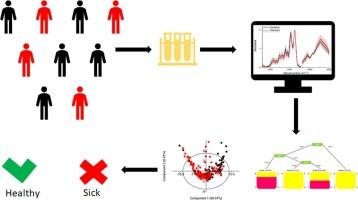Fourier transform InfraRed spectra analyzed by multivariate and machine learning methods in determination spectroscopy marker of prostate cancer in dried serum
IF 4.3
2区 化学
Q1 SPECTROSCOPY
Spectrochimica Acta Part A: Molecular and Biomolecular Spectroscopy
Pub Date : 2024-10-22
DOI:10.1016/j.saa.2024.125305
引用次数: 0
Abstract
Prostate cancer represents the second most prevalent form of cancer in males globally. In the diagnosis of prostate cancer, the most commonly utilised biomarker is prostate-specific antigen (PSA). It is unfortunate that approximately 25 % of men with elevated PSA levels do not have cancer, and that approximately 20 % of patients with prostate cancer have normal serum PSA levels. Accordingly, a more sensitive methodology must still be identified. It is imperative that new diagnostic methods should be non-invasive, cost-effective, rapid, and highly sensitive. Fourier transform infrared spectroscopy (FTIR) is a technique that fulfils all of the aforementioned criteria. Consequently, the present study used FTIR to assess dried serum samples obtained from a cohort of prostate cancer patients (n = 53) and a control group of healthy individuals (n = 40). Furthermore, this study proposes FTIR markers of prostate cancer obtained from serum. For this purpose, FTIR spectra of dried serum were measured and analysed using statistical, chemometric and machine learning (ML) algorithms including decision trees C5.0, Random Forest (RF), k-Nearest Neighbours (kNN) and Support Vector Machine (SVM). The FTIR spectra of serum collected from patients suffering from prostate cancer exhibited a reduced absorbance values of peaks derived from phospholipids, amides, and lipids. However, these differences were not statistically significant. Furthermore, principal component analysis (PCA) demonstrated that it is challenging to distinguish serum samples from healthy and non-healthy patients. The ML algorithms demonstrated that FTIR was capable of differentiating serum collected from both analysed groups of patients with high accuracy (values between 0.74 and 0.93 for the range from 800 cm−1 to 1800 cm−1 and around 0.70 and 1 for the range from 2800 cm−1 to 3000 cm−1), depending on the ML algorithms used. The results demonstrated that the peaks at 1637 cm−1 and 2851 cm−1 could serve as a FTIR marker for prostate cancer in serum samples. Furthermore, the correlation test indicated a clear correlation between these two wavenumbers and four of the five clinical parameters associated with prostate cancer. However, the relatively small number of samples collected only from patients over the age of 60 indicated that the results should be further investigated using a larger number of serum samples collected from a mean age range. In conclusion, this study demonstrated the potential of FTIR for the detection of prostate cancer in serum samples, highlighting the presence of distinctive spectroscopic markers associated with the analysed cancer type.

用多元和机器学习方法分析傅立叶变换红外光谱,确定干血清中前列腺癌的光谱标志物
前列腺癌是全球第二大男性癌症。在前列腺癌的诊断中,最常用的生物标志物是前列腺特异性抗原(PSA)。遗憾的是,约 25% PSA 水平升高的男性并没有罹患癌症,约 20% 的前列腺癌患者血清 PSA 水平正常。因此,还必须找到一种更灵敏的方法。新的诊断方法必须是非侵入性的、具有成本效益的、快速的和高灵敏度的。傅立叶变换红外光谱(FTIR)是一种符合上述所有标准的技术。因此,本研究使用傅立叶变换红外光谱评估了前列腺癌患者(53 人)和健康对照组(40 人)的干燥血清样本。此外,本研究还提出了从血清中获取的前列腺癌傅立叶变换红外标记物。为此,使用统计学、化学计量学和机器学习(ML)算法(包括决策树 C5.0、随机森林(RF)、k-近邻(kNN)和支持向量机(SVM))测量和分析了干燥血清的傅立叶变换红外光谱。从前列腺癌患者血清中采集的傅立叶变换红外光谱显示,磷脂、酰胺和脂类的吸光度降低。然而,这些差异在统计学上并不显著。此外,主成分分析(PCA)表明,区分健康和非健康患者的血清样本具有挑战性。ML 算法表明,傅立叶变换红外光谱能够以较高的准确度(800 cm-1 至 1800 cm-1 范围内的数值在 0.74 和 0.93 之间,2800 cm-1 至 3000 cm-1 范围内的数值在 0.70 和 1 之间)区分从两组被分析患者采集的血清,具体取决于所使用的 ML 算法。结果表明,1637 cm-1 和 2851 cm-1 处的峰值可作为血清样本中前列腺癌的傅立叶变换红外标记。此外,相关性测试表明,这两个波长与与前列腺癌相关的五个临床参数中的四个之间存在明显的相关性。不过,由于从 60 岁以上患者中采集的样本数量相对较少,因此应使用从平均年龄范围内采集的更多血清样本对结果进行进一步研究。总之,这项研究证明了傅立叶变换红外光谱在检测血清样本中前列腺癌方面的潜力,并强调了与所分析癌症类型相关的独特光谱标记的存在。
本文章由计算机程序翻译,如有差异,请以英文原文为准。
求助全文
约1分钟内获得全文
求助全文
来源期刊
CiteScore
8.40
自引率
11.40%
发文量
1364
审稿时长
40 days
期刊介绍:
Spectrochimica Acta, Part A: Molecular and Biomolecular Spectroscopy (SAA) is an interdisciplinary journal which spans from basic to applied aspects of optical spectroscopy in chemistry, medicine, biology, and materials science.
The journal publishes original scientific papers that feature high-quality spectroscopic data and analysis. From the broad range of optical spectroscopies, the emphasis is on electronic, vibrational or rotational spectra of molecules, rather than on spectroscopy based on magnetic moments.
Criteria for publication in SAA are novelty, uniqueness, and outstanding quality. Routine applications of spectroscopic techniques and computational methods are not appropriate.
Topics of particular interest of Spectrochimica Acta Part A include, but are not limited to:
Spectroscopy and dynamics of bioanalytical, biomedical, environmental, and atmospheric sciences,
Novel experimental techniques or instrumentation for molecular spectroscopy,
Novel theoretical and computational methods,
Novel applications in photochemistry and photobiology,
Novel interpretational approaches as well as advances in data analysis based on electronic or vibrational spectroscopy.

 求助内容:
求助内容: 应助结果提醒方式:
应助结果提醒方式:


